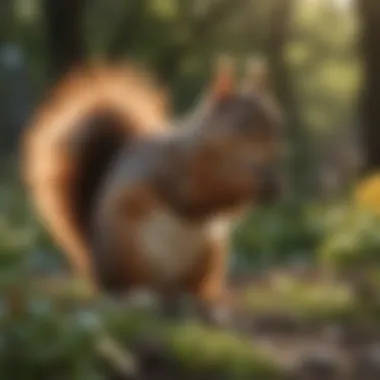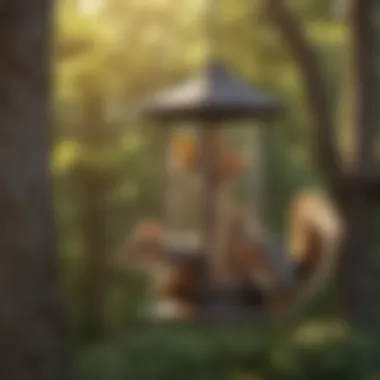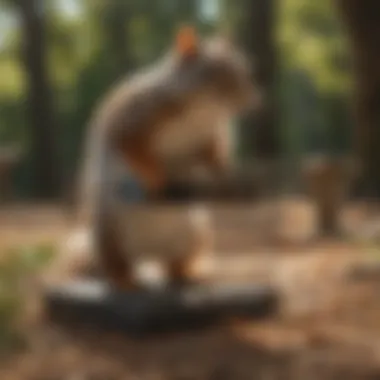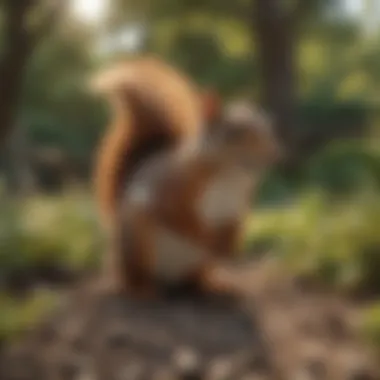Effective Strategies for Tree Squirrel Management


Intro
Tree squirrels are common inhabitants of suburban environments, often leading to conflicts with homeowners. Understanding their behavior, prevention, and removal strategies is essential. This article offers a comprehensive examination of effective methods for managing tree squirrels in residential yards.
Pest Identification
Identifying tree squirrels is the first step in managing their presence in your yard. There are two primary species commonly found in residential areas: the Eastern Gray Squirrel and the Fox Squirrel.
- Eastern Gray Squirrel: Typically gray with a bushy tail, these squirrels are agile climbers, often found in trees or near bird feeders. They are medium-sized, and their social behavior can be observed through their vocalizations.
- Fox Squirrel: Slightly larger than the gray variety, the Fox Squirrel has a rust-colored coat with a bushy tail. They prefer open woodlands and can be seen foraging on the ground.
Signs and Symptoms of Infestations
Homeowners may notice several indicators of squirrel activity:
- Nesting: Look for nests built in trees or attics, often made from twigs and leaves.
- Chewing Damage: Squirrels chew on plants, wiring, and even furniture, which can indicate their presence.
- Droppings: Small, dark droppings can be found where squirrels frequent.
By recognizing these signs early, homeowners can take timely action to address potential squirrel issues before they escalate.
Prevention Strategies
Preventing tree squirrels from becoming pests requires a proactive approach. Here are key strategies that can be implemented:
Home Maintenance Tips for Pest Prevention
- Sealing Entry Points: Inspect your home for cracks and openings, especially around attics and basements. Seal any gaps to prevent squirrels from entering.
- Removing Food Sources: Store bird seed, pet food, and any food waste securely. Keep outdoor compost bins covered.
- Trimming Trees: Regularly trim tree branches that are close to your home to reduce access routes for squirrels.
Natural Deterrents and Barriers
- Spicy Deterrents: Spraying a mixture of water and cayenne pepper on plants can deter squirrels due to their sensitivity to spicy substances.
- Physical Barriers: Use mesh fencing around gardens to keep squirrels away from desired areas.
Treatment Options
If prevention methods do not resolve the issue, homeowners may consider treatment options. It is essential to weigh the choices between chemical and natural treatments:
Overview of Chemical vs. Natural Treatments
- Chemical Treatments: These include commercial repellents that are available at stores. However, one must cautiously follow the directions to avoid harming unintended wildlife.
- Natural Treatments: Using simple household items, such as vinegar or citrus peels, can effectively repel squirrels with fewer risks to the environment.
Step-by-Step Guides for DIY Treatments
To create a natural repellent:
- Collect Ingredients: Gather water, cayenne pepper, and dish soap.
- Combine Ingredients: Mix two tablespoons of cayenne pepper, one tablespoon of dish soap, and one quart of water in a spray bottle.
- Spray Application: Apply the mixture to areas where squirrels are active, repeating every few days or after rain.
Important Note: Always consider local regulations about wildlife management before taking further action.
By understanding tree squirrels and implementing proactive measures, homeowners can efficiently manage their presence, ensuring a harmonious balance in their outdoor spaces.
Understanding Tree Squirrels
Understanding tree squirrels is essential for homeowners dealing with these agile creatures. Tree squirrels are often viewed as pests, but gaining knowledge about their biology, behaviors, and the species present in residential areas can lead to more effective management strategies.
Biological Characteristics
Tree squirrels belong to the family Sciuridae, a diverse group of rodents. They have specific physical traits that help them thrive in various environments. Their bodies are built for climbing, with strong hind legs and long tails that assist in balance. Generally, adult tree squirrels weigh between 1 to 1.5 pounds, with their fur colors ranging from gray to reddish-brown, depending on the species.
Their sharp incisors grow continuously, allowing them to gnaw on a variety of materials, including wood, nuts, and even plastic. This characteristic highlights the importance of understanding how their dental structure affects their behavior and habitat choices. Households with trees or readily available food sources may find themselves attracting these animals.


Behavioral Patterns
Tree squirrels exhibit intriguing behavioral patterns. They are primarily diurnal, meaning they are active during the day. This activity peak often occurs during the early morning and late afternoon hours. During these times, squirrels forage for food, socialize, and establish their territory.
Squirrels communicate with one another using a range of vocalizations and body language. Their alarm calls warn other squirrels of potential threats, prompting them to seek cover. Understanding these behaviors is vital as it helps homeowners anticipate squirrel activity and adjust their property management accordingly.
Moreover, tree squirrels are known for their hoarding behavior, storing nuts and seeds for winter. This practice increases the likelihood of them raiding gardens or yards for food items, making awareness of their foraging habits a necessity.
Common Species in Residential Areas
Three primary species of tree squirrels are commonly found in residential areas: the Eastern gray squirrel, the Fox squirrel, and the Red squirrel.
- Eastern Gray Squirrel: Known for its adaptability, this species is prevalent across North America. They are characterized by their bushy tails and gray fur, often with white underbellies.
- Fox Squirrel: This species has a larger size compared to the gray squirrel. Its coat is usually a mix of gray and reddish-brown. Fox squirrels often prefer open woodlands and parks, making them likely visitors in suburban landscaping.
- Red Squirrel: Smaller than the other two, the red squirrel has reddish fur. They tend to establish territory in coniferous forests but can also adapt to urban settings.
Being aware of these species can help homeowners identify the specific type of squirrel they are dealing with, which can lead to more targeted management strategies. Knowing their habits facilitates the development of effective preventive measures.
Assessing the Squirrel Problem
Assessing the squirrel problem is a foundational step for anyone wishing to manage tree squirrels effectively in their yards. Understanding the magnitude of the issue is crucial in deciding the appropriate strategies for control. Ignoring early signs of squirrel activity may lead to more significant problems down the line—problems that could involve damage to property, disruption of personal space, or even resultant conflicts with neighbors. Thus, taking the time to thoroughly assess the squirrels’ presence is both beneficial and necessary.
Identifying Signs of Squirrel Activity
To take appropriate action against squirrel infiltration, one must first identify signs of their activity. Squirrels tend to leave distinct marks in their wake. Common indicators include:
- Nesting Materials: Squirrels often collect twigs, leaves, and other debris for nests. Look for nests high in trees or tucked away in attics.
- Chewing Damage: Squirrels have strong teeth designed for gnawing. You might notice chew marks on outdoor furniture, wires, or garden plants.
- Droppings: Squirrel droppings are typically small, cylindrical, and dark in color. Finding these around your property can confirm their presence.
- Scurrying Sounds: Listen for sounds of scurrying in your attic or around trees, especially during dawn or dusk when they are most active.
Identifying these signs allows homeowners to understand when their yard is becoming a favorite haven for squirrels. Early detection is critical to avoid escalation.
Evaluating the Extent of the Infestation
Once signs of squirrel activity are evident, the next step is to evaluate how bad the situation is. This evaluation involves a practical assessment of activity levels and potential risks. Consider the following aspects:
- Frequency of Sightings: How often do you see squirrels in your yard? Frequent visits indicate a greater likelihood of nesting nearby.
- Damage Assessment: Inspect your yard and home for any signs of damage caused by squirrels. This includes plants, wires, and any exposed areas that squirrels may use to access your home.
- Nesting Locations: Determine how many potential nesting sites exist in your yard. If a family of squirrels is present, their numbers can quickly multiply.
The evaluation stage is essential as it guides the subsequent measures you may take. By understanding the extent of the problem, you can better tailor your management strategies.
In summary, proper assessment of the squirrel problem is vital for formulating effective control strategies.
Preventive Measures
Preventive measures are critical in managing tree squirrels effectively in residential areas. By proactively addressing the conditions that attract squirrels, homeowners can significantly reduce the likelihood of an infestation. Implementing modifications in yard design, maintaining the outdoor space, and utilizing natural deterrents all play a vital role in this strategy.
Yard Design Modifications
Yard design modifications can greatly influence the presence of squirrels. First, it is important to assess the plants and trees in your yard. Certain species, like oak and hickory, produce nuts that are particularly appealing to squirrels. Consider removing or replacing these plants with non-nut-bearing options. Moreover, maintaining a clean landscape by regularly raking up fallen nuts and seeds is essential. This reduces food availability and, consequently, the interest of squirrels in your outdoor space.
Creating barriers can also be helpful. Installing fencing or other structures around gardens can deter access. Additionally, managing tree branches that overhang roofs is crucial, as squirrels are adept climbers and can easily access homes if branches provide a bridge.
"Prevention is often more effective and humane than removal."
Conducting Regular Maintenance
Regular maintenance of the yard is paramount for preventing squirrel intrusion. This includes inspecting bird feeders, as these can be treasure troves for squirrels. If you do use bird feeders, ensure they are designed to be squirrel-proof. This might involve using heavier materials or purchasing specialized feeders that limit access.
Additionally, keep garbage bins tightly sealed. Open trash can draw squirrels looking for easy meals. Drainage areas should be clear of debris to ensure pests do not have easy access points. By routinely checking and cleaning these areas, you minimize the risk of creating an inviting environment for squirrels.
Using Natural Deterrents


Natural deterrents can be an effective strategy in keeping squirrels at bay. Certain scents, for example, are known to repel squirrels. Spraying a citrus solution or placing cotton balls soaked in peppermint oil around your yard may discourage them from entering. Other options include using capsaicin, the active ingredient in hot peppers, which can be applied to plants and seeds to deter squirrels without harming them.
Another effective deterrent is strategically introducing predator scents. Items such as fox urine or commercial products designed to emulate these scents can make the area feel unsafe for squirrels, prompting them to seek refuge elsewhere. By using these non-invasive techniques, homeowners can maintain control over their gardens while respecting local wildlife.
Implementing these preventive measures provides a foundation for effective squirrel management. Through conscious design choices, regular upkeep, and natural repellents, homeowners can create an environment that is less appealing to tree squirrels.
Humane Removal Techniques
Understanding humane removal techniques is crucial for any homeowner who wants to manage tree squirrels in a way that is both effective and ethical. Squirrels often adapt well to suburban environments, which can lead to conflicts with residents. It is essential to approach these conflicts thoughtfully, balancing the desire to protect property with the responsibility to treat wildlife humanely.
Humane removal involves capturing and relocating squirrels without causing harm. This practice not only helps maintain local biodiversity but also aligns with ethical standards many homeowners wish to uphold. Employing humane methods minimizes stress for the animals and reduces the risk of injury.
Live Trapping Methods
Live trapping is one of the primary humane techniques used to manage squirrel populations. A variety of commercially available traps can be found in stores or online. The most common traps include single-door traps, which allow for easy access for the squirrel while preventing escape. When using these traps, it is important to follow a few fundamental steps:
- Choose the right trap size: Ensure the trap is appropriate for the species you are dealing with. Common tree squirrels are typically 15 to 20 inches long, so select a trap that accommodates their size.
- Bait wisely: Use food that squirrels find irresistible. Peanut butter, sunflower seeds, or apples work well as bait.
- Set traps correctly: Place traps in areas where you have noticed squirrel activity. This can include near nests, feeding sites, or along frequent travel routes.
- Check regularly: Regularly inspect the traps to minimize the duration that a squirrel spends inside. This reduces stress for the animal and ensures its wellbeing.
In addition to these steps, it's crucial that once a squirrel is trapped, it is handled with care to avoid injury or distress.
Relocation Protocols
Once squirrels have been captured, the next phase involves relocation. It is important to adhere to local laws regarding wildlife relocation. Many jurisdictions have specific regulations governing how and where animals can be released. Key considerations for relocation include:
- Distance from capture site: Relocating squirrels 5 to 10 miles away from the capture site is recommended. This distance helps prevent the animal from returning to its original territory.
- Choosing the relocation site: A suitable site is critical. Look for areas that provide adequate food sources, shelter, and suitable habitats, such as parks or wooded areas. Avoid urban areas that might pose risks to the animal.
- Timing: The best time for relocation is during daylight hours, as squirrels are diurnal and will be less stressed in familiar daytime conditions.
Moreover, familiarize yourself with potential health issues or behavior changes squirrels might experience when relocated. Understanding their needs can aid in ensuring a successful transition to their new environment.
Community Resources and Assistance
Many communities offer resources that assist homeowners in managing their squirrel populations humanely. These can include:
- Local wildlife organizations: Reach out to local animal shelters or wildlife rehabilitation centers for advice, support, and potential services. They may also conduct workshops or provide educational materials on humane practices.
- Collaborating with neighbors: Sometimes, working together with neighbors can create a broader understanding of the issue and promote community engagement in squirrel management.
- Online forums and groups: Platforms such as Reddit or dedicated Facebook groups can provide not only support but also shared experiences from other homeowners, tips, and successful strategies.
Engaging with community resources can enhance your approach to humane squirrel removal and create a sense of shared responsibility.
In summary, humane removal techniques for tree squirrels ensure a balanced approach to managing wildlife in residential areas. These methods not only aid homeowners but also protect the welfare of the animals involved.
Chemical Control Measures
Chemical control measures can be a significant part of managing tree squirrels effectively. This approach primarily focuses on using specific products designed to deter or manage squirrel populations in a safe and regulated manner. Chemical solutions can offer advantages when employed thoughtfully, as they may provide immediate relief from the nuisances caused by these animals. However, it is crucial to balance the effectiveness of these measures with safety, particularly for households with pets and children. Understanding the nuances of chemical control allows homeowners to incorporate them responsibly within their broader management strategies.
Overview of Chemical Solutions
There are a range of chemical solutions available that target tree squirrels. Most products fall into two primary categories: repellents and poisons.
- Repellents: These are substances that create an unpleasant environment for squirrels, often utilizing strong odors that squirrels find aversive. Examples include products containing capsaicin, which is derived from hot peppers. Homeowners can find various formulations, both liquid and granular, easily available at garden stores or online platforms.
- Poisons: These chemicals aim to reduce the squirrel population directly but should be used as a last resort due to their significant risks, especially to non-target animals and pets. Products like Rodenticides may be labeled for use against squirrels, but there is a serious need for caution.
Using them improperly could have serious ramifications not just for local wildlife, but also for the ecosystems in a given area.
Safety Considerations
When integrating chemical solutions into squirrel management, safety must be a top priority. Here are some specific factors to consider:
- Pet and Child Safety: Many products present risks. For example, if using poisons, ensure they are inaccessible to pets and children. Look for products that are explicitly labeled as safe for use around families.
- Environmental Impact: Always consider how chemicals affect the surrounding environment. Chemical runoff can harm plants, soil organisms, and water sources. Using repellents often has a lesser environmental impact.
- Follow Label Instructions: Each product comes with specific instructions. Compliance is essential to ensure effectiveness and minimize potential hazards. Avoid guessing and adhere strictly to the manufacturer's guidance.
- Store Chemicals Properly: Keep chemicals in secure, labeled containers away from living spaces. Proper storage ensures that accidental exposure does not occur.
It's essential to evaluate the need for chemical control measures carefully. While they can offer benefits, a long-term, integrated pest management strategy often proves to be more effective and sustainable for controlling tree squirrel populations.


Legal and Ethical Considerations
Managing tree squirrels effectively requires an understanding of the legal and ethical facets involved. Responsible squirrel management is deeply intertwined with local laws and the welfare of wildlife. Homeowners must navigate these considerations to ensure they comply with regulatory standards while promoting the humane treatment of squirrels. Embracing these principles can lead to effective results and foster a sustainable coexistence with nature.
Understanding Local Laws
Laws governing the management of tree squirrels can vary widely between regions. Many jurisdictions have specific regulations regarding the trapping, relocation, and harm of wildlife. It is crucial for homeowners to familiarize themselves with these laws to avoid legal repercussions.
Some key points include:
- Trapping Regulations: Many areas require specific permits to trap squirrels. Homeowners should consult local wildlife agencies to understand their rules.
- Relocation Laws: Some regions prohibit the relocation of wildlife due to concerns about transporting diseases or disrupting local ecosystems. Understanding local policies helps in selecting the appropriate course of actions.
- Harmful Practices: Local statutes often outlaw inhumane methods of squirrel control, emphasizing the necessity of humane treatment.
Residents can find relevant laws through local government websites or consult organizations such as the Association of Fish and Wildlife Agencies. Awareness of these laws enables proactive management and humane treatment of squirrels.
Ethical Treatment of Wildlife
Ethical considerations are paramount when dealing with tree squirrels. Wildlife is an essential part of the ecosystem, and ethical treatment reflects the respect we owe to other creatures that share our space. Homeowners should approach squirrel management with a humane outlook to minimize suffering and promote biodiversity.
The following principles should guide ethical squirrel management:
- Humane Trapping: Using live traps allows for the safe capture of squirrels without causing harm. This approach gives homeowners the chance to relocate squirrels away from residential areas, which is better for the animals and the environment.
- Avoiding Poisons: The use of poisons poses significant threats to non-target animals and can lead to suffering. Ethical management avoids such methods in favor of preventive and humane approaches.
- Promoting Coexistence: Instead of viewing squirrels solely as pests, consider strategies to coexist. Wildlife-friendly gardening, food placement strategies, and deterrents can discourage intrusion without requiring removal.
"Approaching wildlife with respect and consideration leads to better outcomes for all involved."
In summary, aligning squirrel management efforts with legal and ethical considerations promotes responsible practices that prioritize the welfare of the animals and comply with regulations. Homeowners can maintain their landscape while ensuring that their actions are constructive and compassionate toward wildlife.
Long-term Management Strategies
Managing tree squirrels effectively requires a thoughtful approach that emphasizes long-term strategies. By integrating strategies that promote habitat modification and community engagement, homeowners can enhance their yards’ resistance to squirrel infestations. This section will discuss the importance of creating an environment less conducive to squirrels and how collaboration with neighbors can lead to sustainable solutions.
Building a Squirrel-resistant Environment
Creating a squirrel-resistant environment involves intentional modifications to your yard. This means focusing on factors that attract squirrels and finding ways to minimize those attractions. To begin, consider the following strategies:
- Eliminate Food Sources: Squirrels are often drawn to easily accessible food. Regularly clean up fallen fruits, nuts, and pet food outside. Bird feeders should be squirrel-proof or placed in areas less accessible to them.
- Secure Trash Bins: Make sure trash is in tightly sealed containers, as open trash can be an inviting feast for squirrels. This step alone can significantly reduce their visits.
- Tree Maintenance: Trimming branches that are near the house can limit squirrels’ access. Ensure branches are at least six feet away from your roof.
- Plant Selection: Choose plants and shrubs that are less appealing to squirrels. Avoid varieties that produce mast, like acorns and beech nuts, which are highly attractive.
These strategies not only help in reducing squirrel populations but also contribute positively to your yard’s overall ecological balance. Engaging with local gardening communities or utilizing resources on websites like britannica.com can provide valuable insights into squirrel-resistant flora.
Community Collaboration
In addition to individual efforts, community collaboration is essential for effective long-term management of tree squirrels. Squirrels do not recognize property lines, and a singular approach may yield varying results. Therefore, fostering an understanding among neighbors is crucial. Some ways to enhance community efforts include:
- Neighborhood Meetings: Hosting or attending community meetings to discuss squirrel management can foster collective action. Sharing experiences and successful strategies can empower homeowners.
- Creating a Squirrel Management Plan: Developing a plan that includes agreed-upon measures for prevention and removal can standardize efforts. When everyone is on board, the overall effectiveness increases.
- Resource Sharing: Sharing resources for humane traps, deterrents, and educational material can make community management more efficient.
- Local Engagement: Participating in local wildlife discussions on platforms like reddit.com or in community Facebook groups helps to keep everyone informed and involved.
The End
In managing tree squirrels in residential yards, understanding both the ecological significance of these creatures and the implications of their activities is crucial. Homeowners gain several benefits from adopting effective strategies outlined in this article. These strategies not only help to minimize nuisance behaviors but also foster a balanced coexistence with local wildlife.
Summary of Strategies
The key strategies identified throughout this article focus on preventing squirrel intrusions, employing humane removal techniques, and ensuring compliance with legal considerations. Here are some highlights:
- Preventive Measures: Regular yard maintenance, installation of squirrel-proof feeders, and modification of landscape can significantly reduce squirrel activity.
- Humane Removal Techniques: Employ live trapping methods that follow ethical guidelines, along with community resources that can assist in this process.
- Chemical Control: If necessary, knowledgeable application of chemical deterrents can be incorporated while considering safety and environmental impact.
- Legal Knowledge: Staying informed about local laws regarding wildlife management helps in making responsible choices.
Call for Responsible Practices
As we think about managing tree squirrels, it is essential to approach the situation with mindfulness. Effective management should not come at the cost of inhumane treatment of wildlife. Homeowners are encouraged to:
- Educate themselves about the behavior of tree squirrels and their role in the ecosystem.
- Use non-lethal options whenever possible and prioritize humane strategies in removal and control efforts.
- Collaborate with neighbors and local wildlife organizations to address larger community-wide issues related to squirrel populations.
Responsible practices reflect our commitment to both personal property and the environment. Managing tree squirrels should be an opportunity to engage with wildlife positively.
In summary, effective squirrel management demands attention, knowledge, and compassion. By applying these strategies wisely, homeowners not only protect their property but also contribute to healthy community ecosystems.



